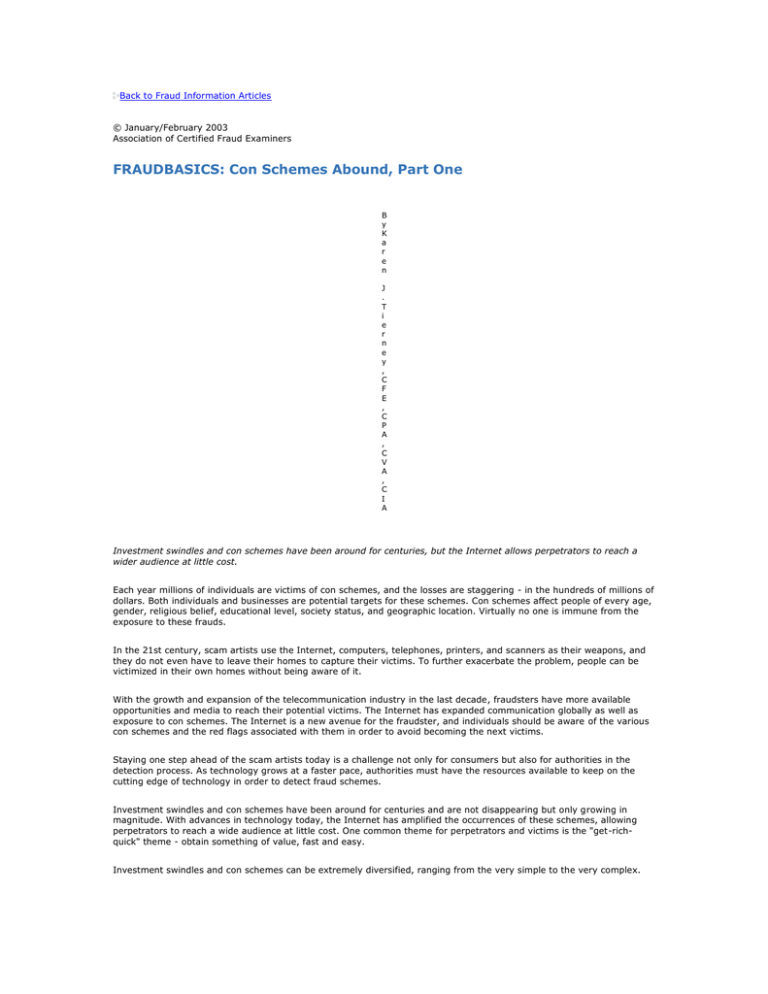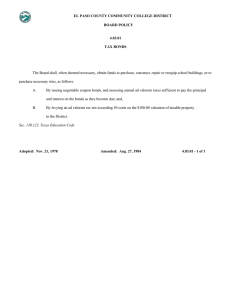FRAUDBASICS: Con Schemes Abound, Part One
advertisement

Back to Fraud Information Articles © January/February 2003 Association of Certified Fraud Examiners FRAUDBASICS: Con Schemes Abound, Part One B y K a r e n J . T i e r n e y , C F E , C P A , C V A , C I A Investment swindles and con schemes have been around for centuries, but the Internet allows perpetrators to reach a wider audience at little cost. Each year millions of individuals are victims of con schemes, and the losses are staggering - in the hundreds of millions of dollars. Both individuals and businesses are potential targets for these schemes. Con schemes affect people of every age, gender, religious belief, educational level, society status, and geographic location. Virtually no one is immune from the exposure to these frauds. In the 21st century, scam artists use the Internet, computers, telephones, printers, and scanners as their weapons, and they do not even have to leave their homes to capture their victims. To further exacerbate the problem, people can be victimized in their own homes without being aware of it. With the growth and expansion of the telecommunication industry in the last decade, fraudsters have more available opportunities and media to reach their potential victims. The Internet has expanded communication globally as well as exposure to con schemes. The Internet is a new avenue for the fraudster, and individuals should be aware of the various con schemes and the red flags associated with them in order to avoid becoming the next victims. Staying one step ahead of the scam artists today is a challenge not only for consumers but also for authorities in the detection process. As technology grows at a faster pace, authorities must have the resources available to keep on the cutting edge of technology in order to detect fraud schemes. Investment swindles and con schemes have been around for centuries and are not disappearing but only growing in magnitude. With advances in technology today, the Internet has amplified the occurrences of these schemes, allowing perpetrators to reach a wide audience at little cost. One common theme for perpetrators and victims is the "get-richquick" theme - obtain something of value, fast and easy. Investment swindles and con schemes can be extremely diversified, ranging from the very simple to the very complex. Who Are the Perpetrators and Victims of These Schemes? There is no clear perpetrator profile; he may appear in any form. The perpetrator could be someone who has poor morals or conscience, be an absconder who takes money and runs, or has a "wheeler-dealer" attitude. Nor is there an accurate victim profile. All consumers are victims either directly or indirectly. Everyone is vulnerable to the right pitch, and we are all potential victims. Why Do the Perpetrators Commit These Con Schemes? Society promotes admiration for people who possess an abundance of wealth. This admiration promotes pride, which cultivates greed. Perpetrators usually commit these schemes because they are looking for a way to make easy money with minimal effort. However, there may be other factors that drive or motivate the perpetrators to commit con schemes, which may include the three basic elements for fraud to occur: situational pressure; perceived opportunity; and rationalization of the act. Why do Consumers Become Victims to These Schemes? Consumers generally have a trusting nature. They want to believe and trust people, which leaves them vulnerable to fraudsters. They may be looking for easy solutions to problems. They may be risk takers who lack the awareness to recognize a potential con scheme. They knowingly provide information to be helpful and informative but are unaware of its end use. The consumer may become a victim by the application of the same three elements that are present for fraud to occur: situational pressure; perceived opportunity; and rationalization of the act. Potential victims may have or believe to have situational pressures such as a lack of money, low income, or high personal debt. They may have a need to conserve money, or they may have a problem, which requires a solution, for example, home repair. Potential victims may perceive an offer or con scheme as an opportunity to receive something of value or a solution to a problem. Consequently, they may perceive a particular investment as an offer to increase their wealth, or the home repair appears to be a bargain, which saves money. Potential victims will rationalize their actions, that is to make money, save money, solve a problem, receive something of value, provide help or a service, or to obtain or retain credibility. What are the Red Flags That Characterize These Con Schemes? The red flags that generally characterize these con schemes include the following: advance fees required with cash, credit card, or checking account number; promises of substantial profits or returns on investment; promises of little or no risk guaranteed; sense of urgency in response/must act immediately; little or no effort and/or experience required; and refunds not available or difficult to obtain. Generally, as the old saying goes, if it sounds too good to be true, it is probably is. How are These Con Schemes Executed? Con artists are skilled marketers who are capable of developing effective marketing strategies, which include a target and an appropriate marketing mix: promotion, product, price, and place to lure their victims. Victimization is achieved by a successful marketing strategy by the perpetrator. Con artists' marketing strategies generally involve a specific target market of affinity groups consisting of individuals with similar purposes, bonds, or associations. These may include age, gender, religion, social status, geographic location, business or industry, hobbies or activities, or professional status. The perpetrators gain the victims' trust by affiliating themselves with these groups. The con artists initially use various mediums of communication to lure the victim. The fraudulent schemes begin with offers or invitations through the Internet, mail, telephone, newspapers and magazines, television, radio, or door-to-door. Once the consumer receives the offer, the perpetrator requests a response or acceptance. A response will usually include calling a toll-free telephone number or other telephone number. Otherwise, if the perpetrator makes the offer by telephone or door-to-door, then the consumer is solicited directly. The con artists may use high-pressure sales tactics to promote the schemes and lure the consumers with their wellversed scripts. They generally use these techniques to obtain consumers' trust, give them hope, offer promises and easy solutions, as well as provide them with investment or moneymaking opportunities. The perpetrators may also create or provide the three basic elements for fraud to occur - situational pressure, perceived opportunity, and rationalization of the act - to execute their con schemes and successfully lure the victims to take the bait. For example, a telemarketer or door-to-door contractor may suggest to an elderly person that her roof should be repaired otherwise her house may collapse (situational pressure). The perpetrator informs the elderly person that his company has skilled professionals available to perform the work at a competitive or low price (perceived opportunity). Furthermore, the work will not only fix the problem but will also add value to the home for resale or inheritance purposes (rationalization of act). Effects On Consumers Everyone is a potential victim but, as mentioned earlier, everyone also feels the effects of these schemes either directly or indirectly. The direct effects of these con schemes on victims may be financial, emotional, sociological, psychological, and/or physical. Financially, victims may have lost their life savings or their credit histories may have been destroyed. Emotionally, they may feel betrayed, shamed, helpless, angry, guilty, as well as fearful. Sociologically, they may believe they have lost professional credibility in business and the respect of family and friends. Psychologically, they can become depressed or have sleeping disorders. Physically, they may experience health problems that may be attributed to the financial, emotional, psychological, and/or sociological effects. Indirectly, these schemes affect all consumers over time. Economically, investment swindles and other con schemes lead to increases in the cost of credit, health insurance, and taxes. The cost of providing security to cover losses that financial institutions bear as a result of these con schemes is reflected in the high interest rates charged to consumers for credit. The effects of these con schemes on victims may lead them to some type of health care, and the increase in health care demands fosters an increase in the rates of health insurance. Law enforcement and other government agencies require resources to remain current on advanced technologies used to detect and deter fraud. These resources are acquired through taxes. Investment Schemes Consumers can fall victim to investment schemes though a variety of media. However, currently the most popular medium is the Internet. The Internet enables communication to a large audience while saving on time, effort, and money. Anyone can reach millions of people by building a Web site, posting a message on an on-line bulletin board, participating in live on-line "chat" room discussions, or sending mass e-mails. The Internet allows fraudsters to easily deliver their message with the appearance of validity and credibility, which makes it very difficult for investors, seasoned and amateur, to distinguish between fact and fiction. Hundreds of on-line investment newsletters have appeared on the Internet. While legitimate on-line newsletters provide valuable analysis information, other newsletters provide the means to perpetrate fraud. Although it is not illegal for fraudsters to pay people to write glowing recommendations, the federal securities laws require that newsletters disclose who paid them, the amount, and the type of payment, which fraudsters fail to provide. They mask sources of unbiased information by falsely claiming to independently research the stocks they profile as they convince investors to buy or sell specific stocks. Some notorious fraudsters will "scalp" the stocks they hype by driving up the price of a stock without any basis and then sell their own holdings at high prices and high profits. Bulletin boards are another popular medium on the Internet through which investors share information regarding various investment opportunities. Fraudsters use these bulletin boards to "pump up" a company or pretend to divulge "inside" information. Bulletin boards allow users to hide their identities behind multiple aliases making it difficult to distinguish whether the message is true or fraudulent. The message may be from a company insiders, large shareholders, or paid promoters although they claim to be unbiased observers. Junk e-mail or spam enables fraudsters to send personalized messages to millions of Internet users for bogus investment schemes or disseminate false information regarding companies, targeting more potential investors than cold calling or mass mailing. Securities and commodities fraud is big business. Securities regulators have estimated it totals about $400 billion a year. A potential investor must do the proper research by obtaining and conducting an analysis of financial statements, investigating company officers and directors, verifying lucrative contracts, and accessing the Securities and Exchange Commission's (SEC) EDGAR database to confirm registration. Potential investors should also contact state security regulators, the North American Securities Administrators Association, and the National Association of Securities Dealers Inc. If the company is not required to register with the SEC because they are exempt, producing less than $5 million in a 12-month period, they are required to file an offering circular under Regulation A or Form D. Bonds Bonds scams can begin with a cold call from a broker or information sent through the mail; however, bond scams usually occur through the Internet. As previously discussed, spams, e-mails, newsletters, and bulletin boards all provide opportunities for these frauds to occur. The investor has to distinguish between fact and fiction, perform research, and consider the sources of information. Scams often tout high returns, low risk, and immediate action. Junk Bonds Junk bonds are high-yield, low-rated, or non-rated instruments issued by a company that is considered to be a higher credit risk. The credit rating of a high-yield bond is considered "speculative" grade or below "investment" grade. Therefore, the possibility of default with high-yield bonds is higher than other bonds. High yield or "junk bonds" acquired their name from their characteristics. Since most investors were restricted to investment grade bonds, speculative grade bonds soon developed a negative connotation and were not widely held in investment portfolios. They soon became known as junk bonds because few investors would accept the risk of owning them. Before the 1980s, most junk bonds resulted from a decline in credit quality of former investment grade issuers. This was a result of a major change in business conditions or the assumption of too much risk by the issuer. These issues were known as "fallen angels." The modern portfolio theory of financial researchers soon began to observe that the "risk-adjusted" returns for portfolios of junk bonds were quite high, meaning the credit risk of these bonds was more than compensated for by their higher yields. Thousands of individual investors were attracted to junk bonds in the 1980s because of their high rate of return, despite the high risk. Investors chose to ignore prospectuses' warnings and the financial weaknesses of the bonds in pursuit of high yields. Companies, being creative and profit-oriented, began issuing new bonds for issuers that were less than investment grade. An example of this was the Drexel-Burnham scandal, in which Michael Milken led a major investment charge into junk bonds in the late 1980s that ended with the collapse of many lower-rated issuers. Despite this situation, the 1990s recovered with a number of various high yield issues, which currently thrive. Mutual funds have been established that invest exclusively in high yield bonds, which continue to have high risk-adjustment returns. Zero Coupon Bonds Zero coupon bonds are debt securities that are issued at substantial discounts from the face value, offer no periodic interest payments, and pay the principal amount or face value at maturity. They may include obligations of the U.S. Treasury, governmental agencies, municipalities, or corporations. Investors buy zero coupon bonds at a substantial discount from their face value, which is the amount a bond will be worth when it "matures" or comes due. With the discount, an investor can put up a small amount of money that can grow over many years. The maturity dates on zero coupon bonds are usually long-term - 10 years, 15 years, or longer. These long-term maturity dates allow an investor to plan for a long-range goal. Because zero coupon bonds pays no interest until maturity, unlike conventional bonds which pay interest twice a year depending upon the coupon rate of the bond, their prices fluctuate more than any other type of bonds in the secondary market. When a zero coupon bond matures, the investor will receive one lump sum equal to the initial investment plus interest that has accrued. Although zero coupon bonds do not pay interest until they mature, investors may still have to pay federal, state, and local income tax on the imputed or "phantom" interest that accrues each year. Some investors avoid paying the imputed tax by buying municipal zero coupon bonds (if they live in the state where the bond was issued the interest is generally tax-exempt) or purchasing the few corporate zero coupon bonds that also have tax-exempt status. Investors can purchase different kinds of zero coupon bonds in secondary markets that have been issued from a variety of sources, including the U.S. Treasury, corporations, and state and local government entities. The Bond Market Association has more information about zero coupon bonds. Fraudulent schemes sometimes use zero coupon bonds as a promotional tool to attract consumers. Some states have restricted the use of coupon bonds to be used in promotions for big-ticket items, e.g., vehicles, furniture, and houses. These promotions are often misleading to consumers, because they fail to inform them of the true nature of the zero coupon bond. The following is a typical promotional pitch: FREE! A $5,000 U.S. TREASURY BOND FULLY GUARANTEED WITH THE PURCHASE OF A NEW DELUXE LAND CRUISER Consumers enticed by the pitch, aggregate resources with a group and purchase bonds in volume with the hope of reselling the bonds and receiving significant profits. The consumer is often misled and does not fully understand that the $5,000 represents the maturity value of the bonds in 30 years and that the face value of the bond or current value of the bond is $200. Consumers become victims because they are not informed of the value of the bonds at liquidation, tax consequences, and the volatile impact of interest rates on these bonds. Next issue: more investment schemes Karen J. Tierney, CFE, CPA, CVA, CIA, is an ACFE Regent, and president of Karen J. Tierney, CPA, P.C., in Glastonbury, Conn. Her e-mail address is: Tierne@mindspring.com. The Association of Certified Fraud Examiners assumes sole copyright of any article published in Fraud Magazine. Fraud Magazine follows a policy of exclusive publication. Permission of the publisher is required before an article can be copied or reproduced. Requests for reprinting an article in any form must be e-mailed to: FraudMagazine@ACFE.com.




